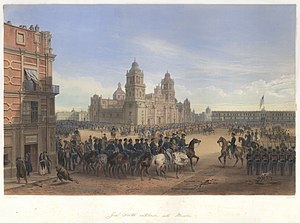All of Mexico Movement
The All of Mexico Movement, or All Mexico Movement, was a political movement to expand the United States to incorporate all of Mexico.[1] It was a controversial aspect of Manifest Destiny that was unable to garner enough political support to encourage adoption. The Mexican-American War (1846–1848) brought the United States and Mexico into conflict over various geopolitical issues, including a desire to invade and annex much of Mexico, that resulted in victory for the United States.
After the US Army took Mexico City, there was renewed enthusiasm for incorporating all of Mexico. There was fierce opposition to the idea within the U.S. Congress over various internal political disputes. The US army found themselves in the midst of guerilla warfare in Tamaulipas, between Veracruz and Mexico City, making it impossible for America to take any effective control of Mexico, while simultaneously losing men, supplies and military equipment. While the American forces in Tamaulipas tried to subjugate the local population through violence and terror, in Mexico City and Veracruz, they tried to respect and not interfere with the local population. Both approaches failed, and it was only due to this increase in violence and insurrection that Mexican leaders saw the necessity of establishing a peace with the US. Similarly, it was urgent for the US to end the conflict and maximize territorial gains while minimizing unneeded losses.
Background
[edit]
Before US President James K. Polk took office in 1845, the US Congress approved the annexation of Texas. After the annexation, Polk wished to affirm control of the region of Texas between the Nueces River, where Mexico claimed Texas's southern border to be, and the Rio Grande, where Texas declared the border to be when they declared independence from Mexico in 1836. This conflict paved the way for the outbreak of the Mexican–American War on April 24, 1846.
US success on the battlefield by the summer of 1847 encouraged calls for the annexation of all of Mexico, particularly by eastern Democrats, who argued that bringing Mexico into the Union would be the best way to ensure peace in the region.[citation needed]
Opposition
[edit]The proposal to annex all of Mexico was controversial. Idealistic advocates of Manifest Destiny, such as John L. O'Sullivan, had always maintained that the laws of the United States should not be imposed onto people against their will. The annexation of all of Mexico would violate that principle and find controversy by extending US citizenship to millions of Mexicans.
That debate brought to the forefront one of the contradictions of Manifest Destiny. Identitarian ideas inherent in Manifest Destiny suggested that Mexicans, as people of color, would present a threat to white racial integrity and so were not qualified to become US citizens, but the "mission" component of Manifest Destiny suggested that Mexicans would be improved (or "regenerated," as it was then described) by bringing them into American democracy. Identitarianism promoted Manifest Destiny but was also used to oppose Manifest Destiny.
An example of this identity-based and racist position was that of John C. Calhoun, Senator from South Carolina, former vice president and future spokesperson for southern secession, in which, in his own words in a speech to Congress on January 4, 1848, he explained that: [We] have never dreamt of incorporating into our Union any but the Caucasian race the free white race. To incorporate Mexico, would be the very first instance of the kind of incorporating an Indian race; for more than half of the Mexicans are Indians, and the other is composed chiefly of mixed tribes. I protest against such a union as that! Ours, sir, is the Government of a white race.[2]
Supporters of total annexation of "All Mexico" regarded it as an anti-slavery measure. Many Americans were troubled by Mexico's Catholicism, weak republicanism, and threat of an upsurge in nationalism.[3][4]
Final result
[edit]The controversy was eventually ended by the Mexican Cession, which added the territories of Alta California and Nuevo México to the United States, both more sparsely populated than the rest of Mexico. Like the All of Oregon movement, the All of Mexico movement quickly abated.
The historian Frederick Merk, in Manifest Destiny and Mission in American History: A Reinterpretation (1963), argued that the failure of the All of Oregon and All of Mexico movements indicates that expansion was not as popular as historians have traditionally portrayed it to have been. Merk wrote that belief in the beneficent mission of democracy was central to American history, but aggressive "continentalism" was an aberration supported by only a minority of Americans, mostly Democrats, but opposed by Whigs and some Democrats. Thus, Louisiana Democrats opposed the annexation of Mexico,[5] while those in Mississippi supported it.[6]
See also
[edit]References
[edit]- ^ Frederick Merk, Manifest destiny and Mission in American History (1963).
- ^ "A Southern Senator Opposes the "All-Mexico" Plan · SHEC: Resources for Teachers". shec.ashp.cuny.edu. Retrieved 2024-04-28.
- ^ Pinheiro, John C. "'Religion without Restriction:' Anti-Catholicism, All Mexico, and the Treaty of Guadalupe Hidalgo," Journal of the Early Republic (2003): 69-96. in JSTOR
- ^ Karl Jack Bauer (1974). The Mexican War, 1846-1848. U of Nebraska Press. p. 370. ISBN 0803261071.
- ^ Billy H. Gilley, "'Polk's War' and the Louisiana Press." Louisiana History (1979): 5-23 in JSTOR.
- ^ Robert A. Brent, "Mississippi and the Mexican War." Journal of Mississippi History (1969) 31#3 pp: 202-14.
Further reading
[edit]- Fuller, John Douglas Pitts. The Movement for the Acquisition of All Mexico, 1846-1848. Baltimore 1936.
- Lambert, Paul F. "The Movement for the Acquisition of All Mexico." Journal of the West XI (April 1972) pp. 317–27.

